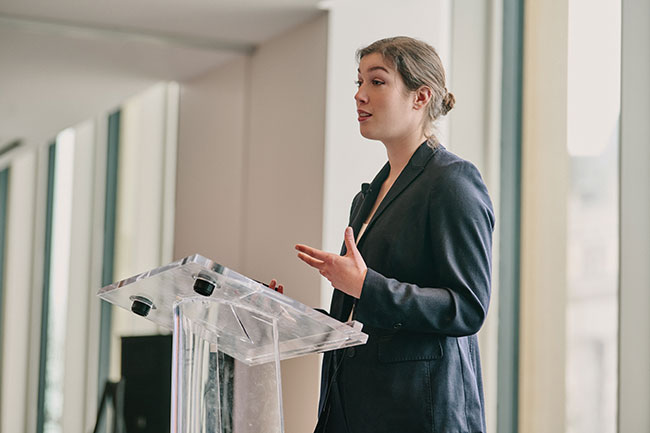
Inaugural Student Innovation Challenge produces fresh ideas for Canada’s egg sector
Brett Ruffell
Features Mariève Dallaire-Lamontagne from Université Laval, speaking here at Egg Farmers of Canada’s AGM, was a joint winner of the challenge.
PHOTo: Egg Farmers of Canada
Mariève Dallaire-Lamontagne from Université Laval, speaking here at Egg Farmers of Canada’s AGM, was a joint winner of the challenge.
PHOTo: Egg Farmers of Canada The Egg Farmers of Canada proudly unveiled the winners of its first-ever Student Innovation Challenge, a platform where post-secondary students nationwide showcased their inventive research ideas and solutions aimed at shaping the future of Canada’s egg sector.
Roger Pelissero, Chair of Egg Farmers of Canada, expressed his excitement about the students’ creativity and their dedication to addressing challenges and seizing opportunities within the egg farming industry. He emphasized the importance of evidence-based research in driving innovation in the sector.
Students were tasked with submitting videos answering the question: “What is your research project that can shape the future of the egg industry in Canada?” The response was overwhelming, with numerous students sharing their fresh and inspiring ideas.
Advertisement
Mariève Dallaire-Lamontagne from Université Laval and Ravneet Kaur from the University of Alberta emerged as the joint winners, with Violet Hipkin from the University of Guelph securing third place. Dallaire-Lamontagne’s project focuses on giving egg production residue a second life using insects. Kaur’s explores the potential of eggs to increase protein intake in individuals recovering from cancer treatment. And Violet Hipkin’s project focuses on pecking blocks for laying hens.
Drew Black, CEO of Egg Farmers of Canada, congratulated all participants for their contributions to the Student Innovation challenge, highlighting the significant role students play in positively impacting the sector’s future.
This challenge marks the newest addition to Egg Farmers of Canada’s research program, which includes various initiatives such as the Research Grant Program, a Research Chairs Network, and several research partnerships.
Print this page